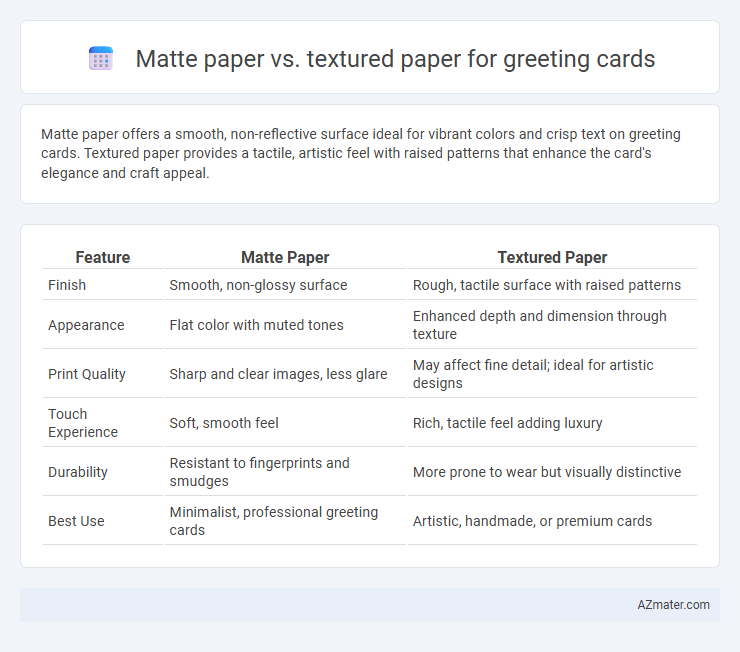Matte paper offers a smooth, non-reflective surface ideal for vibrant colors and crisp text on greeting cards. Textured paper provides a tactile, artistic feel with raised patterns that enhance the card's elegance and craft appeal.
Table of Comparison
| Feature | Matte Paper | Textured Paper |
|---|---|---|
| Finish | Smooth, non-glossy surface | Rough, tactile surface with raised patterns |
| Appearance | Flat color with muted tones | Enhanced depth and dimension through texture |
| Print Quality | Sharp and clear images, less glare | May affect fine detail; ideal for artistic designs |
| Touch Experience | Soft, smooth feel | Rich, tactile feel adding luxury |
| Durability | Resistant to fingerprints and smudges | More prone to wear but visually distinctive |
| Best Use | Minimalist, professional greeting cards | Artistic, handmade, or premium cards |
Introduction to Greeting Card Paper Types
Matte paper for greeting cards offers a smooth, non-glossy finish that enhances written messages and vibrant colors with minimal glare. Textured paper provides a tactile surface with patterns like linen or felt, adding a sophisticated and handcrafted feel to cards. Choosing between matte and textured paper depends on the desired aesthetic and the type of printing technique used, influencing the card's overall visual impact and tactile experience.
Overview of Matte Paper
Matte paper for greeting cards offers a smooth, non-glossy finish that reduces glare and enhances readability, making it ideal for detailed text and images. Its surface absorbs ink well, providing vibrant colors and true-to-design printing without reflection. Matte paper's elegant, understated look suits both professional and personal greeting cards, emphasizing clarity and sophistication.
Overview of Textured Paper
Textured paper for greeting cards offers a tactile, embossed surface that enhances the card's visual appeal and gives a premium, handcrafted feel. Unlike matte paper, which has a smooth, flat finish, textured paper includes patterns such as linen, hammered, or felt finishes that add depth and dimension to the design. This type of paper is ideal for special occasions where a sophisticated, artisanal presentation is desired.
Visual Aesthetics: Matte vs Textured
Matte paper offers a smooth, non-reflective surface that enhances color vibrancy and provides a sleek, modern look for greeting cards. Textured paper introduces tactile elements like linen or watercolor finishes, adding depth and a handcrafted, artistic feel that elevates visual interest. Choosing between matte and textured paper depends on the desired aesthetic impact--matte for clean elegance and textured for rich, tactile sophistication.
Print Quality and Color Reproduction
Matte paper offers smooth, non-reflective surfaces that enhance fine detail and sharp print quality on greeting cards, making colors appear muted but elegant. Textured paper, such as linen or felt finishes, creates a tactile dimension that can subtly diffuse ink, resulting in softer color reproduction with a unique artistic effect. Choosing between matte and textured paper depends on whether crisp visual clarity or a distinguished, handcrafted aesthetic is preferred for the greeting card's design.
Writing Experience: Pen and Ink Compatibility
Matte paper offers a smooth surface that enhances pen and ink compatibility, allowing for crisp, clean lines without bleeding or smudging, ideal for detailed handwriting. Textured paper provides a tactile feel but can cause ink to spread unevenly, potentially leading to feathering or blotches, which may affect legibility. For greeting cards emphasizing handwritten messages, matte paper ensures a more consistent writing experience with various pen types, including fountain pens and gel inks.
Durability and Handling
Matte paper offers a smooth surface that resists fingerprints and smudges, enhancing durability for greeting cards handled frequently. Textured paper provides a tactile feel that can withstand wear while offering a distinct, premium appearance, though it may be more susceptible to dirt accumulation in the grooves. Both options ensure sturdy paper weights, but matte excels in easy handling and longevity in everyday use.
Cost Comparison
Matte paper generally offers a more budget-friendly option for greeting cards due to its simpler production process and widespread availability, often costing 10-20% less than textured paper. Textured paper involves additional manufacturing steps that add to the overall expense, making it a premium choice for cards requiring a tactile, unique finish. For large volume printing, choosing matte paper can significantly reduce costs without compromising print quality.
Best Uses for Matte and Textured Papers
Matte paper offers a smooth, non-reflective finish ideal for greeting cards with vibrant colors, fine details, or photographic images, enhancing readability and creating a professional look. Textured paper provides a tactile feel with patterns like linen or canvas, making it perfect for elegant, handcrafted designs, invitations, or cards meant to convey a personal, artistic touch. Choosing between matte and textured depends on the desired visual impact and the emotional response you want to evoke in recipients.
Choosing the Right Paper for Your Greeting Card Needs
Matte paper offers a smooth, non-glossy finish that enhances readability and provides a classic, elegant look for greeting cards, making it ideal for minimalist or text-heavy designs. Textured paper, with its tactile surface variations like linen or felt, adds a luxurious, handcrafted feel that elevates cards meant to convey warmth and personal touch. Selecting between matte and textured paper depends on the desired visual impact, card purpose, and the recipient's experience, ensuring the paper choice complements the overall message and presentation.

Infographic: Matte paper vs Textured paper for Greeting card
 azmater.com
azmater.com